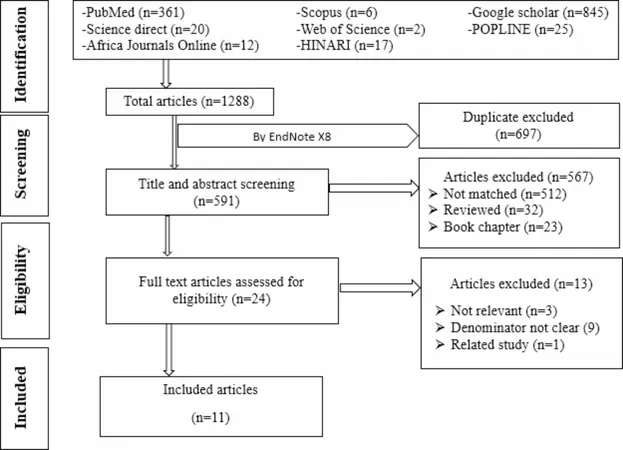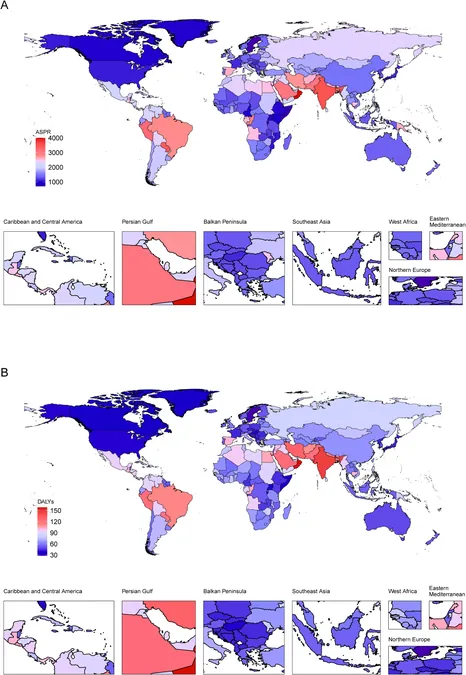
Shocking Findings on Asymptomatic Leishmania donovani Infections in Ethiopia: What You Need to Know!
2025-01-17
Author: Wei
Background
Visceral leishmaniasis, also known as kala-azar, poses a significant public health challenge in Ethiopia, being endemic to the region and primarily caused by the parasite Leishmania donovani. One of the most alarming aspects of this disease is the existence of asymptomatic carriers—individuals infected with the parasite who do not exhibit any clinical signs. These asymptomatic individuals act as a hidden reservoir, complicating efforts to control and eliminate the disease. Despite the pressing need for comprehensive data on asymptomatic infections, significant gaps in knowledge still exist in Ethiopia, prompting the need for a systematic review and meta-analysis.
Methods
The systematic review adhered to PRISMA guidelines and was registered with PROSPERO (CRD42024531454). Searches were conducted across multiple electronic databases and grey literature sources until April 13, 2024, and only original research articles published in English were considered. Statistical analyses utilized STATA version 16, and publication bias was assessed using various methods, including funnel plots. The overall prevalence of asymptomatic L. donovani infection was calculated using a random effects model.
Results
From an initial pool of 1,288 articles, 11 studies were included in the final analysis. These studies spanned 17 districts and reported a total of 7,288 subjects. Notably, laboratory testing techniques varied, but the prevalence of asymptomatic L. donovani infections ranged dramatically—individual studies reported rates from as low as 0.9% to as high as 15.8%. On average, the pooled estimate of asymptomatic infections across Ethiopia stood at 9.0% (95% CI: 6.0-11.0%), suggesting a serious public health concern.
Interestingly, the data revealed that individuals living in households with domestic animals had more than double the odds (OR: 2.54) of being asymptomatically infected, as did males (OR: 2.22), highlighting demographic and environmental risk factors.
Conclusion
The findings underscore the critical need to address the substantial number of asymptomatic L. donovani infections in Ethiopia. It is evident that having close contact with domestic animals and being male increase the likelihood of infection, suggesting that routine screening for asymptomatic infections should be implemented. These efforts could help stem the tide of visceral leishmaniasis and pave the way for more effective disease management strategies.
Global Context
Visceral leishmaniasis remains one of the most neglected tropical diseases, with global annual new case estimates ranging from 50,000 to 90,000. Ethiopia is a significant player in the epidemiology of this disease, with an annual case estimate ranging from 3,700 to 7,400. Understanding asymptomatic carriers is crucial, as they can contribute to the transmission dynamics of the parasite and impede eradication efforts.
The reality is sobering: many individuals may harbor the parasite without ever showing symptoms, complicating surveillance and intervention. The presence of asymptomatic infections is not just a matter of academic research; it is directly connected to public health policies and disease control initiatives.
Actionable Insight
Given the alarming prevalence of asymptomatic L. donovani infections, better surveillance, and proactive screening programs must be deployed. Moreover, collaboration between healthcare providers, policymakers, and communities is essential to identify at-risk populations and reduce transmission effectively. Understanding and addressing the complex interplay of environmental, demographic, and health factors is the key to tackling this hidden crisis head-on.
As we move forward, it is paramount to integrate findings from this study into actionable health strategies to safeguard populations at risk. Stay informed, stay safe, and be a part of the solution in combating visceral leishmaniasis!




 Brasil (PT)
Brasil (PT)
 Canada (EN)
Canada (EN)
 Chile (ES)
Chile (ES)
 Česko (CS)
Česko (CS)
 대한민국 (KO)
대한민국 (KO)
 España (ES)
España (ES)
 France (FR)
France (FR)
 Hong Kong (EN)
Hong Kong (EN)
 Italia (IT)
Italia (IT)
 日本 (JA)
日本 (JA)
 Magyarország (HU)
Magyarország (HU)
 Norge (NO)
Norge (NO)
 Polska (PL)
Polska (PL)
 Schweiz (DE)
Schweiz (DE)
 Singapore (EN)
Singapore (EN)
 Sverige (SV)
Sverige (SV)
 Suomi (FI)
Suomi (FI)
 Türkiye (TR)
Türkiye (TR)
 الإمارات العربية المتحدة (AR)
الإمارات العربية المتحدة (AR)